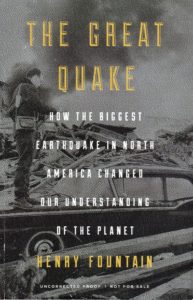Book Review: The Great Quake by Henry Fountain
Disclaimer: I received this uncorrected proof through a Goodreads Giveaway to facilitate this review. No other compensation was offered or requested. As an uncorrected proof, many changes will be made in the final product, due out August 2017, including an index and bibliography, and possibly more illustrations.
March 27, 1964, Good Friday by the Catholic calendar, was the date of the largest earthquake in North American history, magnitude 9.2 on the revised Richter scale. Loss of life was limited due to Alaska’s sparse population at the time, but property damage in the city of Anchorage was severe, and the town of Valdez and Native Alaskan village of Chenega were devastated, requiring the entire communities to move elsewhere.
This book is a detailed examination of that earthquake, with a special focus on George Plafker, a geologist whose research in the aftermath led him to produce evidence for the plate tectonics theory of geophysics.
The opening chapter deals with Mr. Plafker and his colleagues from the U.S. Geological Survey being recalled early to Alaska to assess the damage after the quake. The military was glad to see them, as not only were communications and transportation disrupted, but the network of early warning systems protecting America from nuclear attack was at risk.
Then there are a series of backstory chapters about the communities that were affected and their inhabitants, Mr. Plafker’s decision to become a geologist and early career, and the science of earthquakes and continental drift theory.
This is followed by chapters on the earthquake itself, taken primarily from eyewitness accounts. Then back to the aftermath, rescue measures, reconstruction and the scientific examination of the evidence. Considerable space is devoted to Mr. Plafker’s analysis of the geology, and the formulation of his hypothesis as to the cause.
There’s a chapter on the acceptance of this idea and the advancement of plate tectonics, then an epilogue that details where everyone still alive ended up. The end notes are good, with some extra detail.
The writing is okay, and the events of the earthquake are exciting and horrifying, but I didn’t find the style compelling. (Keep in mind, again, that this is an uncorrected proof; the author may be able to punch it up a bit.) It should be suitable for high school students on up.
Primarily recommended for those interested in Alaskan history, geophysics buffs and those who like to read about earthquakes.

